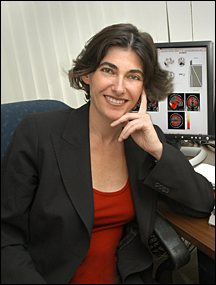Drug-Related Preference In Cocaine Addiction Extends to Images
November 16, 2008
WASHINGTON, D.C. — When given a choice between viewing pictures of cocaine and a variety of other images, cocaine addicted individuals, as compared to healthy, non-addicted research subjects, show a clear preference for the drug-related images. Findings from this study, which was conducted at the U.S. Department of Energy’s (DOE) Brookhaven National Laboratory, will be presented at the Society for Neuroscience annual meeting in Washington D.C. on Sunday, November 16, 2008, at 2:30 p.m. Eastern Time, by Scott Moeller, a psychology graduate student at the University of Michigan who worked with the Brookhaven Lab Neuropsychoimaging group (director, Rita Goldstein) on this research.
“This behavioral study demonstrates for the first time that drug-related choice in cocaine addiction extends to abstract, non-pharmacological stimuli, facilitating the study of choice behavior in addiction without using actual cocaine,” Moeller said. Previously, scientists have had to administer the actual drug (cocaine), or drugs that are pharmacologically similar to cocaine, to test its effects on brain and behavioral functions. Now, the tasks developed by Moeller while training with Goldstein’s team could help clinicians monitor choice behavior — for example, to follow the effectiveness of treatment — in addicted individuals who are currently abstaining from drugs.
In the first task of the experiment, both healthy control subjects and cocaine-addicted individuals digitally selected one of four face-down card decks and could select a card again from the same deck or switch decks. Unknown to the subjects, each deck contained mostly one image type: cocaine-related images, pleasant images, unpleasant images, or neutral ones. This test of choice is considered implicit because subjects were not necessarily aware of their tendency to choose one type of image over the others. In the second, explicit choice task, subjects repeatedly selected between two side-by-side, face-up images taken from the four decks.
On both tasks, the cocaine-addicted individuals chose the cocaine-related images more than the healthy controls, who showed clear aversion to these images. In addition, on the implicit task, healthy control subjects chose pleasant images more than the cocaine-addicted subjects.
Interestingly, cocaine-addicted individuals’ self-reported ratings of how pleasant they thought a picture was did not fully explain these results, nor were these ratings entirely consistent with their choice behavior. For example, while cocaine-addicted individuals rated pleasant images as more pleasant than the cocaine-related images, at the group level they still chose from these two picture categories at the same rates on both tasks. This suggests that drug-addicted individuals may not be fully aware of their own choice behavior or that drug choice in addicted individuals may not be fully driven by the pleasure or reward they get from the drug, as is frequently assumed.
Further, the cocaine-addicted individuals with the greater preference for cocaine-related images over pleasant ones had used cocaine more frequently in the previous month. This finding suggests these tasks could serve as objective measures of the severity of drug use (which, to date, has been measured primarily by self-report).
“Tasks like the ones developed here could be used clinically to predict the effectiveness and outcomes of drug-addiction treatment, including abstinence or relapse,” Goldstein said.
As a follow-up, she added, “Simultaneous neuroimaging studies are needed to investigate the brain structures that underlie choices made by drug-addicted individuals.”
This work was funded by the National Institute on Drug Abuse and the General Clinical Center at University Hospital Stony Brook.
Coauthors on the study included: Thomas Maloney, Nelly Alia-Klein, Patricia A. Woicik, Frank Telang, Gene-Jack Wang, and Rita Z. Goldstein of Brookhaven Lab; Muhammad A. Parvaz, Jonathan P. Dunning, and Greg Hajcak of Stony Brook University; and Nora D. Volkow of the National Institute on Drug Abuse.
*For more information on the Society for Neuroscience annual meeting, go to http://www.sfn.org/am2008.
2008-10864 | INT/EXT | Newsroom










